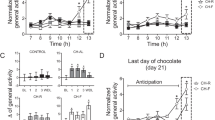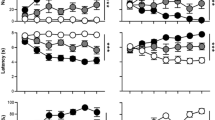Abstract
In consummatory successive negative contrast, rats that have had experience drinking 32% sucrose solution drink significantly less 4% sucrose solution than rats that have drunk only 4% solution. This contrast effect occurs reliably when rats are housed in wire-bottom cages, but it occurs significantly less frequently when rats are housed in polycarbonate tubs. Although it is unclear what causes these differences among housing conditions, the present study underscores the impact that housing conditions outside the domain of the training environment can have on behavioral outcomes.
This is a preview of subscription content, access via your institution
Access options
Subscribe to this journal
We are sorry, but there is no personal subscription option available for your country.
Buy this article
- Purchase on Springer Link
- Instant access to full article PDF
Prices may be subject to local taxes which are calculated during checkout



Similar content being viewed by others
References
Flaherty, C.F. Incentive Relativity (Cambridge University Press, New York, 1996).
Vogel, J.R., Mikulka, P.J. & Spean, N.E. Effects of shifts in sucrose and saccharin concentrations on licking behavior in the rat. J. Comp. Physiol. Psychol. 66(3), 661–666 (1968).
Papini, M.R. Comparative psychology of surprising nonreward. Brain Behav. Evol. 62(2), 83–95 (2003).
Flaherty, C.F., Becker, H.C. & Pohorecky, L. Correlation of corticosterone elevation and negative contrast varies as a function of postshift day. Anim. Learn. Behav. 13, 309–314 (1985).
Mustaca, A.E., Martinez, C. & Papini, M.R. Surprising nonreward reduces aggressive behavior in rats. Int. J. Comp. Psychol. 13(1–2), 91–100 (2000).
Freidin, E. & Mustaca, A.E. Frustration and sexual behavior in male rats. Learn. Behav. 32(3), 311–320 (2004).
Flaherty, C.F., Grigson, P.S. & Rowan, G.A. Chlordiazepoxide and the determinants of contrast. Anim. Learn. Behav. 14, 315–321 (1986).
Mustaca, A.E., Bentosela, M. & Papini, M.R. Consummatory successive negative contrast in mice. Learn. Motiv. 31(3), 272–282 (2000).
Pellegrini, S., Wood, M.D., Daniel, A.M. & Papini, M.R. Opioid receptors modulate recovery from consummatory successive negative contrast. Behav. Brain Res. 164(2), 239–249 (2005).
Rowan, G.A. & Flaherty, C.F. Effect of morphine on negative contrast in consummatory behavior. Psychopharmacology (Berl) 93(1), 51–58 (1987).
Wood, M.D., Daniel, A.M. & Papini, M.R. Selective effects of the delta-opioid receptor agonist DPDPE on consummatory successive negative contrast. Behav. Neurosci. 119(2), 446–454 (2004).
Manser, C.E., Morris, T.H. & Broom, D.M. An investigation into the effects of solid or grid cage flooring on the welfare of laboratory rats. Lab. Anim. 29(4), 353–363 (1995).
Mizisin, A.P., Kalichman, M.W., Garrett, R.S. & Dines, K.C. Tactile hyperesthesia, altered epidermal innervation and plantar nerve injury in the hindfeet of rats housed on wire grates. Brain Res. 788(1–2), 13–19 (1998).
Ortman, J.A., Sahenk, Z. & Mendell, J.R. The experimental production of Renaut bodies. J. Neurol. Sci. 62(1–3), 233–241 (1983).
Raynor, T.H., Steinhagen, W.H. & Hamm, T.E. Differences in the microenvironment of a polycarbonate caging system: bedding vs raised wire floors. Lab. Anim. 17(2), 85–89 (1983).
Briel, J.E., Kruckenberg, S.M. & Besch, E.L. Observations of Ammonia Generation in Laboratory Animal Quarters. Kansas State University NIH Contract, 71–2511 (1972).
Broderson, J.R., Lindsey, J.R. & Crawford, J.E. The role of environmental ammonia in respiratory mycoplasmosis of rats. Am. J. Pathol. 85(1), 115–130 (1976).
Hirsjarvi, P.A. & Valiaho, T.U. Microclimate in two types of rat cages. Lab. Anim. 21(2), 95–98 (1987).
American Conference of Government Industrial Hygienics. Documentation of threshold limit values for substances in workroom air. Cincinatti, OH: ACGIH (1973).
Eisenberger, R., Masterson, F.A. & Over, S. Maintenance-feeding effort affects instrumental performance. Q. J. Exp. Psychol. A 34B, 141–148 (1982).
Shanab, M.E. & Ralph, L. Negative contrast and partial reinforcement effect as a function of crowded rearing conditions in the rat. J. Gen. Psychol. 100, 13–26 (1979).
Lockard, R.B. Some effects of maintenance luminance and strain differences upon self-exposure to light by rats. J. Comp. Physiol. Psychol. 55, 1118–1123 (1962).
Fontella, F.U. et al. Taste modulation of nociception differently affects chronically stressed rats. Physiol. Behav. 80(4), 557–561 (2004).
Vyas, A. & Chattarji, S. Modulation of different states of anxiety-like behavior by chronic stress. Behav. Neurosci. 118(6), 1450–1454 (2004).
Bentosela, M., Ruetti, E., Muzio, R.N., Mustaca, A.E. & Papini, M.R. Administration of corticosterone after the first downshift trial enhances consummatory successive negative contrast. Behav. Neurosci. (in press).
Mustaca, A.E. & Papini, M.R. Consummatory successive negative contrast induces hypoalgesia. Int. J. Comp. Psychol. 18, 255–262 (2005).
Genn, R.F., Tucci, S., Parikh, S. & File, S.E. Effects of nicotine and a cannabinoid receptor agonist on negative contrast: Distinction between anxiety and disappointment? Psychopharmacology (Berl) 177(1–2), 93–99 (2004).
Papini, M.R. & Pellegrini, S. Scaling relative incentive value in consummatory behavior. Learn. Motiv. (in press).
Acknowledgements
This research was supported with funds from the Department of Psychology at TCU.
Author information
Authors and Affiliations
Corresponding author
Ethics declarations
Competing interests
The authors declare no competing financial interests.
Rights and permissions
About this article
Cite this article
Wood, M., Daniel, A., Daniels, E. et al. Effects of housing on consummatory successive negative contrast in rats: wire-bottom cages versus polycarbonate tubs. Lab Anim 35, 34–38 (2006). https://doi.org/10.1038/laban0306-34
Received:
Accepted:
Issue Date:
DOI: https://doi.org/10.1038/laban0306-34



